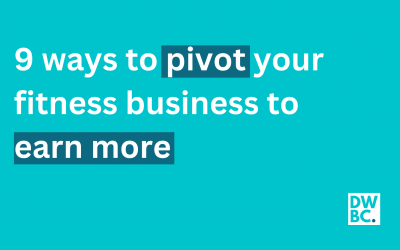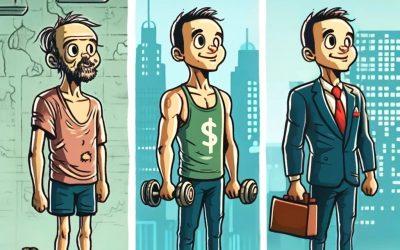This industry will be a tough one to crack.
- You need to cross the chasm from early adopters to mainstream.
- You need to create demand as well as supply.
- You need to position recovery modalities as painkillers, not vitamins.
- You need to buck the trend of first movers often being overtaken by fast followers.
- You need to convince people who’s lives are already hard that they should choose to introduce more hardship.
Adding icebaths, saunas, and other recovery trends to your fitness business is a bad idea.
Before you get offended because you don’t agree, let me explain. I’ll either change your mind, or maybe share some thoughts to turn this bad idea into a good idea.
For clarity, I’ll just collectively call ice baths, saunas, float tanks, cryotherapy chambers, contrast therapy and other things like that, ‘recovery modalities’.
Now, just because I think these recovery modalities are a bad business idea, doesn’t mean they can’t work. Getting in a strangers car is a bad idea. But Uber works pretty well. Inviting strangers to sleep in your house is a bad idea, but airBNB seems to be going alright.
So I’m not saying the inclusion of these recovery modalities won’t work to improve the financial success of your business… but I am saying they probably won’t work, and that you’re better off focusing your attention on different ways to generate income.
Let me explain why, and I’ll start with an example – an example that involves eating bugs.
In 2013, Gabi Lewis and Greg Sewitz founded ‘Exo Bars’ – a company that used flour made from ground up crickets as their key ingredient. This flour substitute was high in protein and very environmentally sustainable.
At first, the company was a huge success. They used influencer marketing to target the paleo, primal, and CrossFit communities – sub-cultures notorious for their cult-like raving fans who were always looking for the next big thing and the latest emerging trend. The high protein, high sustainability, and niche nature of the bars really resonated, and the product took off.
So far so good.
But then the astronomical growth rate began to slow… then stopped.
So what happened? Why the loss of momentum?
What happened, was that these ‘bug bars’ had saturated the paleo, primal, and CrossFit communities, meaning there was no more growth available in that customer segment. And this posed a problem, because beyond this market, a lot of people found the idea of eating insects… pretty gross. People felt uncomfortable about the idea of eating crickets (sort of like how people feel uncomfortable sitting in a bath of ice water – but we’ll get back to that later).
Exo Bars just couldn’t seem to break into the mainstream market to continue their upward trajectory. The ‘novelty factor’ that was the reason for much of the initial success became the very same reason that the company was failing to grow.
Now there’s a fancy name for this inability to break through to a mainstream market, and it’s key for our discussion of the viability of recovery modalities.
It’s called the technology adoption life cycle curve, and it beautifully describes how the population jumps aboard new ideas.
In fancy terms, the shape of the curve is a normal distribution, or a bell curve. But you can picture this graph sort of like a hill in the distance. The sides of the hill are low, and the peak of the hill is high.
When a new idea is launched, not everyone jumps aboard. The people who DO, are called the innovators. The innovators are the first people to start the recovery modality trend. They were eating crickets and having ice baths before they were cool. This group makes up just 2.5% of the population. Once the innovators have shown that they haven’t choked on a grasshopper leg or lost a toes to frostbite, the next group comes along, the early adopters. This is the next 13.5% of the population. A bit later comes the early majority, the late majority, and finally the laggards. To be financially successful, you really need to break into the early majority, which, when combined with the innovators and the early adopters, gives you 50% of the population.
And one of my big problems with recovery modalities as a financially viable business idea is that it’s really hard to break into the majority.
In fact, the difficulty in becoming mainstream has a name. The author Geoffrey Moore called it ‘crossing the chasm’. Let’s go back to picturing that hill. Imagine a giant karate chops a giant canyon half way up, right in the middle of the early adopters. For Exo Bars to go mainstream, they needed to cross this chasm. But they couldn’t. And for ice baths and saunas and float tanks and cryo chambers to go mainstream, they need to cross it too.
So there’s our first problem.
The second problem comes down to the most basic principle of economics – supply and demand. Every Sunday morning I make my daughter banana pancakes. If a tropical cyclone goes through northern Queensland and kills all the bananas, there is less supply, but my daughter still demands her pancakes (ok she doesn’t demand them, she’s a great kid, but you know what I mean). So with less bananas available, but just as many people wanting them, demand outstrips supply, bananas become scarce and the price goes up. A business that sells scarce products and services that people want is a good business to be in.
So why are ice baths and saunas like bananas? Well, that’s the problem, they’re not.
The banana farmers don’t need me to convince me to buy their product, my daughter convinces me.
But you DO need to convince the majority of people that they should be freezing their arse off in an icebath or sweating their face off in a sauna. You don’t need to convince the innovators or the early adopters, but if you want to cross the chasm and be a big financial success, you do need to convince everyone else.
So not only do you need to create the supply – a bath full of cold water for people to sit in, you also need to create the demand. People don’t know they need an ice bath. So you first need to convince them they need this service… and only then can you start to sell it to them. You need to educate people that they need to change their behaviour – and that’s really hard to do.
In episode 22 of The Business of Fitness Podcast, I talked about how to market a sauna, and introduced the idea of Eugene Schwartz’s five stages of awareness. The idea is, you need to market a product or service differently based on the customer’s level of awareness. The stages of awareness are:
- Unaware, where the client doesn’t even know they have a problem that a sauna could help.
- Problem aware, where they know they have a problem but don’t know that a sauna could fix it.
- Solution aware, where they know they have a problem, knows that a sauna could help, but don’t know about your business.
- Product aware, where they know about your business but aren’t convinced it’s the best solution for them, and finally
- Most aware, where the potential client knows your product and that it will solve their problem, they just need to know the deal or offer that will convince them to get started.
The whole point of marketing is to move customers along these levels of awareness until they buy from you. And the more steps you need to take, the more challenging, lengthy and expensive the marketing process.
Look at something like a gym membership. Everyone already knows exercise is good for them, and that it can solve their problems, so all you need to do is tell them about your business and prove to them you’re better than their other options.
Just like me with bananas, I don’t need to be convinced to buy bananas, just which shop to buy them from.
But for these recovery modalities we’re talking about, you first need to convince people that bananas actually exist and that they taste good in a pancake.
You’ve got two additional steps to go through – introduce people to the modality, convince them they need it, then try to sell it to them.
So if you’re struggling with marketing fitness services, prepare yourself for a whole new level of difficulty for recovery modalities, which currently don’t solve a big enough problem for a big enough number of people.
And the idea of solving a problem brings me to the third issue I have.
Most products and services can be separated into either vitamins or painkillers. A vitamin is something someone needs to get healthier when they’re already healthy, and a painkiller is something people need to get back to neutral when they’re unhealthy.
And if humans were logical, we’d know that prevention is better than cure, and we’d spend money with the businesses that offer the ‘vitamin’ solutions. But we’re not logical, and we spend our money on cures – even if it means we end up spending more.
When the economy suffers, interest rates raise, jobs get lost and financial hardship strikes, people stop buying vitamins. But if they get a headache, they’ll always find a way to afford paracetamol.
Ice baths, saunas, float tanks, cryotherapy chambers and contrast therapy are all perceived as vitamins, meaning the business will be on shaky ground and will be the first thing to go in times of hardship. Successful businesses sell painkillers, not vitamins, and successful business owners make themselves indispensable regardless of what’s happening in the world.
Now I can hear what you’re thinking ‘the wave is coming, I want to be on the crest of it when it breaks’. We may be on the crest of a wave of more recovery focussed consumers, and you believe that you’re perfectly positioned to enter this industry before it explodes. We call this ‘first mover advantage’. If you can be the first business to bring a new product to market, you can capture a huge market share before the trend really takes off. This is great in concept. It worked for Apple with the iPod. They promised ‘1,000 songs in your pocket’. As the first mover in the portable MP3 player space they captured a huge segment of the market before their competitors could catch up…or did they?
You see, Apple wasn’t actually the first mover here. That honour went to a company called Diamond Multimedia and their portable MP3 player, the Rio PMP300. Never heard of it? I’m not surprised, it died in 2005, just four years after Apple brought the iPod to market.
The PMP300 may have been first, but because of that, it faced expensive copyright cases from the Recording Industry Association of America, it suffered from incomplete and repurposed technology (sort of like chest freezers as ice baths), and it had an uphill battle to convince consumers to ditch their CDs and the popular Sony Discman.
Once the court cases were won, the tech was advanced, and the consumers were convinced, Apple became a ‘fast follower’. It swept in and sold over 400 million iPods before it phased the product out as it was replaced by the iPhone. The PMP300, with its early mover advantage, sold under 100 thousand units – a financial failure.
So the big risk, is that by being on the crest of the wave, you’ll be like Diamond Multimedia – simply paving the way for Apple to swoop in and dominate the market.
Because even if you’re successful, that success will be your own worst enemy, because big business, with deep pockets will notice yours success, put millions into custom built recovery centres which they’ll franchise, reinvest in marketing and push you out. It’s like the early days of CrossFit, where dirty, dusty garage gyms with unkept bathrooms developed a small minority of raving fans. CrossFit did however manage to cross the chasm, but only when people started taking the business model seriously by opening their wallets.
You know what I like about the idea of ice baths? It’s not the physical benefits, it’s their potential to build mental resilience. As my brother says, ‘doing difficult things makes difficult things easier’. But you know what, not everyone wants to do hard things. I know this is a big generalisation, and there are some exceptions, but people who use ice baths usually have a pretty good life. Sure, they have challenges, but they’re not living in adjunct poverty. And that’s because most people have enough challenge in life without having to add more hardship. The fact that we have the desire to add more hardship is something to be grateful about – life must be pretty good for us to want to make it tougher. So just like breaking through to the mainstream was difficult for the cricket-based Exo Bars because people felt uncomfortable eating crickets, breaking through is going to be tough for recovery modalities because ice baths are really cold, saunas are really hot and spending time alone with your own thoughts in a float tank is really confronting. A lot of people have a lot of struggles – it’s difficult to convince them to pursue more.
So it’s probably pretty obvious that I don’t think this is the best idea for a gym owner. But that doesn’t mean it can’t be done.
If I wanted to include recovery modalities in my own facility, here’s what I’d do.
I’d start by building a minimal viable product. I talk about this in depth in episode 39 of The Business of Fitness Podcast, where I explain how I built a fitness business in three hours for $300. This MVP would be the absolute easiest, most basic, and cheapest version of the final product I could possibly create. Because of the difficulties in launching a business like this, I’d want to test a paired down version before I overcommit.
Secondly, I’d get a pre-commitment from people. If you ask people if they’d use saunas or icebaths in your gym, they’d probably say yes. But when it comes time for them to put their hand in their pocket, they never follow through. What people say they’ll do, and what people actually do are usually very different. You need to get them to put their hand in their pocket to firm up their commitment. Have some sort of pre- sale or deposit that they pay so they’ve got skin in the game. This can prove the financial viability of the product before you spend a cent on it.
The service should be subscription based – not pay-per-use. Recurring payments give you consistency and predictable future cash flow, just like gym memberships.
Then, I’d roll the service out gradually. I wouldn’t spend big money up front. This is basically a continuation of the minimal viable product I mentioned. I’d make a small investment of money and time to make this part of the business as small as possible. If that works, reinvest back into the idea and grow gradually. A big upfront commitment isn’t smart for a high risk venture like this. Other than protecting the downside, this also builds some scarcity into the service, and people want what they can’t have – increasing the demand.
In terms of marketing, I’d focus heavily on a few key areas. The focus of your marketing should be in-house – that is, market to your current clients and members. You’re so used to marketing to the outside world, but here, focus on trying to upsell existing customers.
I’d prioritise education (why people should use these modalities) because remember, you need to create demand as well as supply.
Once people start using the service, document this. Photos, videos, testimonials etc. Normalise the use of these recovery modalities because people tend to go with the crowd.
While we’re talking about normalisation, make sure all new members are sold on this service. Saying something like ‘most of our members also choose to pay $20 extra per week for full access to our recovery zone’ will increase your chances of success and you should get a higher percentage of new clients taking advantage of this service than existing clients.
Finally, find a way to make the use of recovery modalities a habit. How can you piggyback their use onto an existing habit your clients have? Maybe you could actually include some sort of contrast protocol into your programming at the end of a session for example.
This industry will be a tough one to crack. You need to cross the chasm from early adopters to mainstream, you need to create demand as well as supply, you need to position recovery modalities as painkillers, not vitamins, you need to buck the trend of first movers often being overtaken by fast followers, and you need to convince people who’s lives are already hard that they should choose to introduce more hardship.
I’m not saying this can’t be done. But I do believe it would be a really hard idea to get right, and I think you need to examine it from all angles before you commit.
Sometimes a good idea isn’t a good idea, at least not yet.





